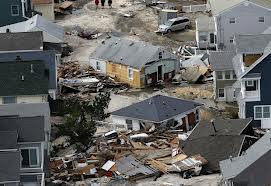The Federal Emergency Management Agency (FEMA), which helps communities recover from natural disasters, is making a big policy change.
It’s been in the works for a couple of years, but in July, President Obama announced that to qualify for preparedness funds, states will soon be required to include details on how they are preparing for climate change impacts. It will put states led by climate deniers in an interesting position.
While states have always had to prepare hazard mitigation plans – which identify risks and how they plan to take action to minimize them – this is the first time they specifically must address climate change. That’s because most states’ use historical data, not forward-looking data that predicts more frequent, severe disasters associated with climate change.
Going forward, states must conduct a formal analysis on those risks as well as policies and projects that make them less vulnerable, ranging from retrofitting buildings to creating new flood zones.
One well publicized example is in North Carolina, where planners were explicitly told they couldn’t use data that projected future sea level rise.

FEMA’s shrunken austerity budget is stretched to the max because $1 billion-plus disasters are growing 5% a year since 1980, according to NOAA. Every $1 spent on prevention saves $4 dollars in recovery assistance, as reported by the National Institute of Building Sciences.
While FEMA has the authority to deny preparedness funds in the absence of a climate change analysis, it will likely be rare. But the threat of losing hundreds of millions of dollars could force states to think about it. Many of the states most in need of help have been Red states governed by climate deniers, such as Louisiana, which received over $1.25 billion, and Texas, more than $880 million, reports InsideClimate News.
The hope is that as states are forced to deal with the issue, they will put pressure on Congress to provide the resources necessary to prepare and adapt.
Read our article, Largest Cities Say Climate Change Threatens Local Businesses.
It’s a huge step in the right direction, says the Natural Resources Defense Council (NRDC), which petitioned FEMA to do this in 2012. What would be even better is if FEMA mapped projected changes, such as sea level rise, so that communities could use that information in their plans. They would also like to see more public participation required and stress the importance of frequently updated plans.
Work is also underway to get FEMA to make better use of climate science in its own budgeting process. In fact, it faces the same learning curve as states because FEMA also relies on historical data.
Because of all the recent distasters, FEMA has had to divert funds from long-term rebuilding projects to cover emergency needs – food, water and shelter – and has been forced to ask a reluctant Congress for additional funds. The National Flood Insurance Program is $18 billion in debt and that will only increase, as floods zones grow from rising sea levels.
Last year, President Obama established the State,
Local, and Tribal Leaders Task Force on Climate Preparedness and Resilience for recommendations on how the Federal government can best respond to community needs regarding climate
change. At the time, he also directed every federal agency to consider climate resilience in every infrastructure project it funds.
FEMA’s new policy is one of their recommendations, here are the others that will be implemented:
